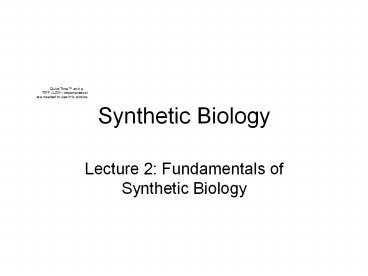Synthetic Biology PowerPoint PPT Presentation
Title: Synthetic Biology
1
Synthetic Biology
- Lecture 2 Fundamentals of Synthetic Biology
2
Fundamentals
- Basic Components
- Promoters, Ribosome Binding Sites, Coding
Sequences, terminators, Plasmids - Isolating components from nature
- Basic Devices
- Inverters, Switches and Memories
3
Promoters
- Regulatory parts (also known as promoters) are
those which provide binding regions for RNA
polymerase, the enzyme which performs the act of
transcription (the production of RNA from a DNA
template)
4
The Lac Promoter
http//web.mit.edu/esgbio/www/pge/lac.html
5
The Lac Promoter
6
The Lac Promoter
7
The Lac Promoter
8
Zinc Finger Promoters
9
Harnessing ZFPs
10
Ribosome Binding Sites
- Landing Site for Ribosomes
- Approximately 10 nt away from AUG
11
RBS Binding
12
RBS Manipulation
- Adjust melting temperature of the Shine-Delgarno
sequence - Add secondary structures to alter binding
13
RBS Manipulation
http//www.nature.com/nbt/journal/v22/n7/images/nb
t986-F1.gif
14
Coding Sequences
- Code for a protein
http//molvis.sdsc.edu/atlas/morphs/lacrep/lacrep_
anim_small.gif
15
Codon Usage
Triplets (codons) of DNA/RNA code for amino
acids Organisms prefer different
codons Re-coding amino acids can result in
improved or reduced translation
http//www.g-language.org/data/haruo/codon_table.g
if
16
Terminators
- Forward and Reverse
- BBa_B0025
http//parts.mit.edu/registry/index.php/PartBBa_B
0025
17
Terminator Efficiency
- Single terminators -
- Forward and reverse efficiency
- Current range -1.09 to .984
- Negative means it acts as a promoter
- Terminators can be combined (B0021B0010B0012)
18
Plasmids
- Circular pieces of DNA that hold our devices
- Origin of Replication
- Copy Number
- Antibiotic Resistance
- Multiple-Cloning Site/BioBrick Insertion Site
19
About Plasmids
http//parts.mit.edu/registry/index.php/HelpPlasm
id_features
20
BioBrick Plasmids
- Different Origins of Replication Required!
- pSB1AK3
- pSB plasmid Synth Bio
- 1 origin of Replication
- AK Resistance (Amp/Kan)
- 3 Version
- Postfixed data is the insert
- See http//parts.mit.edu/registry/index.php/HelpP
lasmids/Nomenclature
21
Plasmid-Plasmid Interactions
22
Taming Nature
- Most parts are derived from natural systems
23
Building Devices
- Devices are themselves parts, but they are built
from several smaller components. - The choice of input/output of a device is very
important, as it determines how parts can be
connected.
24
The Quad Part Inverter
25
Features of QPIs
- Inverters work well because they are non-linear,
and thus they are restorative.
26
The QPI Abstraction Barrier
27
Using Proteins as Signals
28
Wait a sec
- IF we use proteins as our signal carrier, we need
to have inverters that handle all sorts of
input/output combinations!
29
Keep the protein self contained
30
PoPS
-gtPoPS
PoPS-gt
Polymerase Per Second
31
Building a System Description
32
Timing Diagram
33
Drill down to Parts
34
DNA Layout
35
Add Debugging Parts
36
Standard Assembly
- Collect List of Devices to build, and build an
assembly tree. - Push Button Synthesis
- Automated Assembly means you have more time to
test alternatives, test the resulting devices,
and design more.
37
Case Repressilator
38
An Oscillator
39
Actual Behavior is Stochastic
40
System Sensitivity to Parameters
41
Plasmid Layout
42
They Oscillate.. Sort of.
43
Major Issues Raised
- Load on Cells
- Stochastic Variation in performance
- Genetic Stability over time
44
Load
- How many cellular resources does the device use?
- dNTPs (Marginal DNA replication)
- rNTPs (RNA Production)
- RiPS (Ribosomes)
- Amino Acids (Proteins)
- ATP for activity
45
dNTP Load
- Computation based on copy number and device
length in nucleotides - ldNTP ncopylpart
46
RNA Load
- RiPS Usage
- Transcript count(production rate stability),
protein synthesis time - dN/dt P-ND
- Assume synthesis time is proportional to
transcript length tal - NTP usage Nl
47
Amino Acids
- Amino Acids
- Protein length, copies
- ANtranscriptslprotein
- NTranscript length, l protein length
48
ATP (energy)
- Demand is proportional the weighted sum of the
other demands - E?( aLDNAbLRNAcLAA )
- Over all parts, plus the ATP required for coding
sequence function.
49
Dealing with Load
- Need engineered chasses
- Reduced genome organisms (mycoplasma)
- Eliminate key components recombinases, create
dependencies, unnecessary parts.
50
Can we win?

